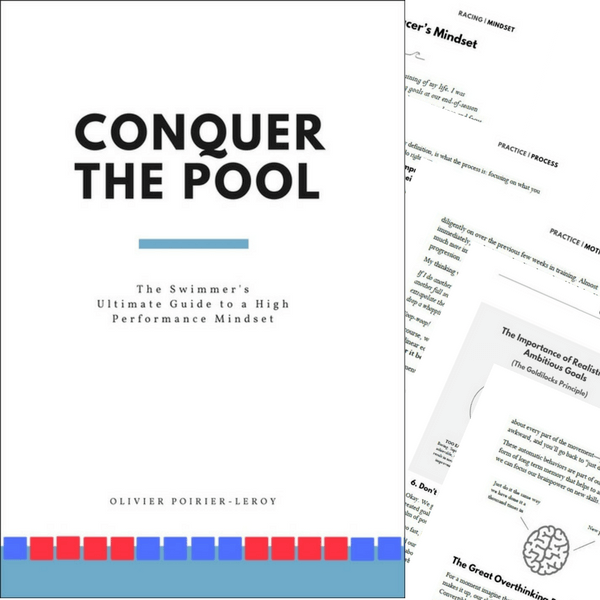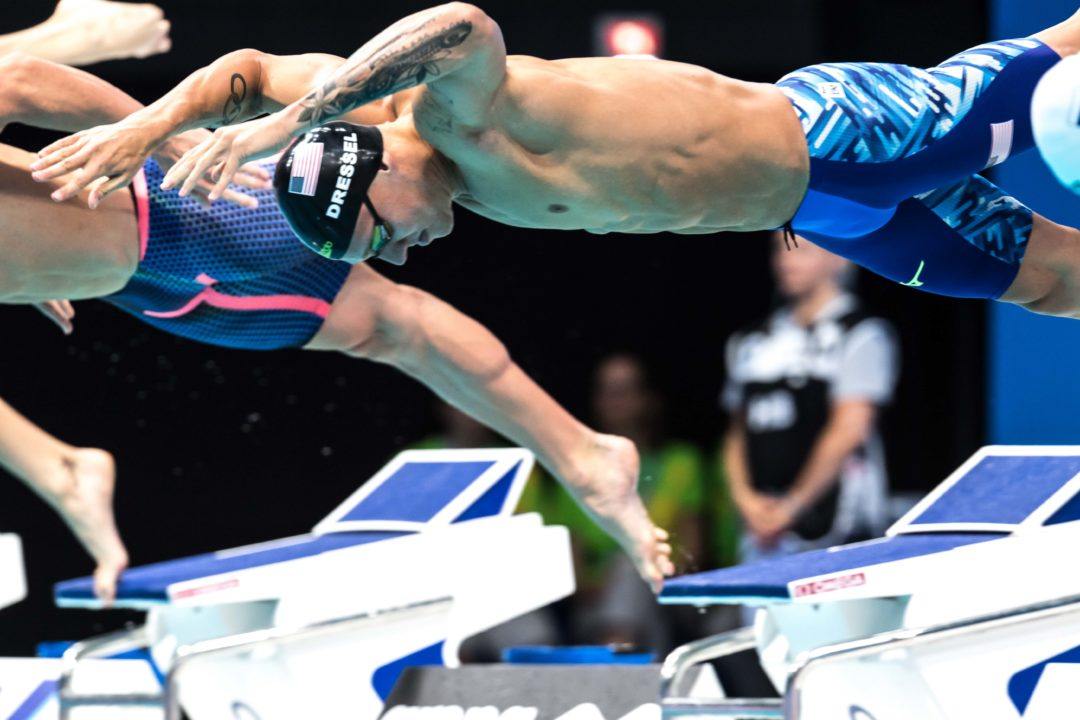by Olivier Poirier-Leroy. You can join his weekly motivational newsletter for competitive swimmers by clicking here.
If you watched the FINA World Championships in Budapest, you were witness to one of the most dominating performances in swimming history.
American Caeleb Dressel decimated the fastest swimmers in the world in the 50 and 100m freestyles and the 100m butterfly. He also rattled the supersuit records in all three of those events, dipping under the 50 second mark in the 100m butterfly, and nearly breaking :21 and :47 in the freestyle sprints.
While Dressel’s consistency was remarkable—he improved with every swim from prelims to semis to finals in every event but one—his start was the thing that got the most attention.
During every race, from the relays, which he usually led off for the Americans, to the 50m freestyle, the fastest event on the program, he exploded to an early lead, often up to a half-body length.
Here are some things you can learn from Caeleb Dressel, the man with the fastest first 15m on the planet:
1. His hips are in a high position on the blocks.
When he is crouched, taking his marks, Dressel’s hips are nice and high.
“This elongates the hamstring and gets the leg ready to fire,” says Jason Calanog, one of Dressel’s coaches at Bolles, and now an assistant coach at Texas A&M. (At that time, the Bolles program also included 100m butterfly Olympic champion Joseph Schooling, 100-200m backstroke Olympic champion Ryan Murphy, and Santo Condorelli, who placed 4th in the 100m freestyle in Rio. That’s a nasty squad.)
Calanog has found that his swimmers are able to get a faster reaction time out of this kind of hip placement. The advantage of a high hip position means that the hamstring is taut and ready to go. If you have your hip low, the muscle ends up having to react and than fire.
2. Huge amount of explosiveness.
Swimmers aren’t traditionally known for being amazing athletes.
We spend so much time in the water that it is hard to achieve blinding levels of athleticism. It’s a running joke that swimmers are uncoordinated on land, and it’s probably no surprise that most of the injuries that swimmers incur are as a result of dryland and strength training.
But the start is inherently a dryland activity. It’s not something you can train in the water; the explosiveness necessary for a fast and powerful start is developed in the weight room.
And make no mistake, Dressel is an athlete there, too.
Here is a video of him cleaning over 260 pounds from blocks:
Think that kind of explosive power helps him fly off the blocks like a missile? Absolutely.
3. He back loads his start.
A lot is made of reaction time off the blocks, and that is generally the metric used when talking about whether or not a swimmer has a good start.
Reaction time doesn’t tell nearly the whole story, even though it’s an easy measurable to lob around. But it doesn’t account for force and acceleration of the athlete when leaving the blocks.
At the FINA World Championships in Budapest, Dressel pummeled everyone on the starts. Half-a-body length pummeled the competition. And yet, his reaction time wasn’t anything that would represent his otherworldly lead at 15m—in the 50m freestyle, for instance, he was third for reaction time (0.62) of the finalists.
What makes his reaction time impressive is that Dressel back-loads his hips on the blocks. Unlike other elite swimmers like Florent Manaudou, who center their hips above their front foot, Dressel’s hips are further back, in a modified slingshot start.
Would Dressel have a slightly faster reaction time if he front-loaded his weight? Maybe. But those one-hundredths of a second he would gain in reaction time he would be forfeiting in terms of power and acceleration.
The start isn’t dominated by who is off the blocks the fastest; it’s who gets to the 15m mark first.
4. Uses his arms.
A common mistake swimmers make on the start is not using their arms to generate propulsion.
We are seeing the arm movement becoming more prominent as younger swimmers are starting with it earlier, but for the most part, swimmers use their arms only in terms of gripping the blocks when awaiting the start and making sure they are in a streamline.
One of the most visibly noticeable aspects of Dressel’s start is that he brings his arms above and around him, creating a coupling motion that helps to generate more distance and momentum into his streamline.
And because he is back-loading his hips on the block, he is also more reliant on his arms to pull him through to gain acceleration off the block. “He pulls back on the block with his arms to use his entire body in the start,” says Calanog. “Most swimmers don’t use their arms.”
As Dressel recently said in an interview in Splash magazine, he makes sure that his “arms do as much work as my legs.”
5. Back foot on an angle off the blocks.
When Dressel leaves the blocks, his legs are not together. Anytime you use a track start this is inevitable, but it also has a purpose. Raising the back foot helps to create a sharper angle of entry when diving into the water.
The key to making this work is something you have probably heard your coach tell you a hundred times—make sure your entire body uses a tight bulls-eye when hitting the water. Aim to dive into the water using the same small hole, from finger tips to toes to get a clean entry.
Having that back foot up “creates a more steep angle into the water,” says Calanog, which helps you hit your bulls-eye.
6. Dressel dolphin kicks like a, well, dolphin.
Dressel maintains excellent speed through the breakout with his dolphin kicks and a tight streamline. You can’t really talk about Dressel’s start without talking about his underwaters, which are among the best in the world.
One of the reasons that it is so strong is that his up-kick is very powerful. Most swimmers can kick towards the bottom of the pool with a nice amount of power, but use the up-kick only as a resetting phase for another down-kick, instead of using the up-kick for more propulsion.
It’s no accident that he kicks this way.
“He’s been working on it for years, with slow, perfect kicks in practice,” says Calanog.
Another reason for his epic start? He dolphin kicks into his first stroke, (something I discussed in this post here) which sends him hurtling into that critical first stroke cycle at top speed.
7. Practice, practice, practice.
For most swimmers, their starts only get attention when the big meet suddenly looms on the horizon.
And so what do they do? They cram in a few sessions’ worth of starts, and never really get the reps in that they need to develop the skill that is inherent in a great start.
For Dressel, and his coaches at Bolles (and now at Florida), this means working on them every day, over years.
H/T: Thank you to Jason Calanog for taking the time to send over his notes and thoughts on his time working with Caeleb at Bolles.
ABOUT OLIVIER POIRIER-LEROY
Olivier Poirier-Leroy is a former national level swimmer. He’s the publisher of YourSwimBook, a ten-month log book for competitive swimmers.
 He’s also the author of the recently published mental training workbook for competitive swimmers, Conquer the Pool: The Swimmer’s Ultimate Guide to a High Performance Mindset.
He’s also the author of the recently published mental training workbook for competitive swimmers, Conquer the Pool: The Swimmer’s Ultimate Guide to a High Performance Mindset.
It combines sport psychology research, worksheets, and anecdotes and examples of Olympians past and present to give swimmers everything they need to conquer the mental side of the sport.
Ready to take your mindset to the next level?
Click here to learn more about Conquer the Pool.
COACHES & CLUBS: Yuppers–we do team orders of “Conquer the Pool” which includes a team discount as well as complimentary branding (your club logo on the cover of the book) at no additional charge.
Want more details? Click here for a free estimate on a team order of CTP.

Cause I’m a rebel just for kicks yeah!
But I do it anyway…
My coach wants to kill me when I try to do anything but “put your arms in a streamline and go.”
I dont get the comparison with manaudou, the other Great starter. Completely different techniques but both extremely dominant.
One day before this article was reposted, the author also posted 5 Reasons You Should Be Doing Lots of Vertical Kicking This Season. In his 4th reason, he stated: “While limited bouts of this (kicking with fins) might be good for developing power, (dolphin) kicking with fins for extended periods of time just promotes poor motor functions. In other words, by doing long, slow (dolphin) kicks with fins on, you learn to do long, slow (dolphin) kicks without fins on”.
Yet in today’s repost, in which he declares Dressel’s dolphin kicking as among the best in the world, he quotes coach Jason Calanog as saying of Dressel: “He’s been working on it (dolphin kicking) for years, with slow, perfect kicks… Read more »
No you do it without fins. The fins are what the author claims promote poor motor function, not the long slow kick training.
Lost me at “Swimmers aren’t traditionally known for being amazing athletes.” That could be worded much better. Like ‘swimmers arent traditionally known to be monsters in the weight room” because amazing swimmers ARE amazing athletes
#8
He picked the right parents.
I am going to be downvoted for this, but it bothers me when a swimmer has so much advantage at the dive already. This is not to take anything away from Dressel, who is ALSO exceptional in the water. And or course I know that the start is part or any race, any sport. But I like the swim to be about the swimming. I guess it’s just me.
Finaly someone said it! Also when are they going to get rid of walls, we need to see the fastest SWIMMER not the fastest streamliner.
I say we put them in a flume, then we will see who is truly the best.
Ok I guess I had this coming 🙂